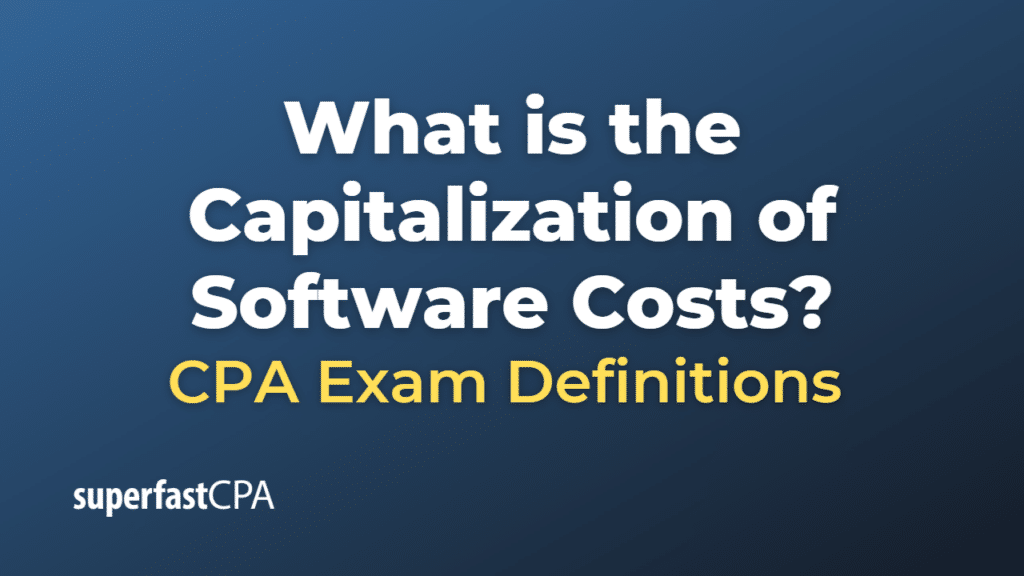Capitalization of Software Development Costs
Capitalization of software costs refers to the accounting practice of recognizing certain costs associated with developing or acquiring software as capital assets rather than expensing them immediately. Capitalizing these costs spreads them over the useful life of the software, as they are recognized gradually through amortization instead of being expensed all at once in the period they were incurred.
Under the Generally Accepted Accounting Principles (GAAP), software costs can be capitalized if they meet specific criteria. These criteria vary depending on whether the software is developed for internal use or to be sold, leased, or marketed externally.
- Software developed for internal use:
According to the Financial Accounting Standards Board (FASB) guidelines, software development costs for internal use can be divided into three stages:
a. Preliminary project stage: Costs incurred during the conceptual formulation and evaluation of alternatives are expensed as incurred.
b. Application development stage: Costs incurred during the design, coding, testing, and installation of the software can be capitalized if they meet specific criteria.
c. Post-implementation/operation stage: Costs related to training, maintenance, and minor upgrades are generally expensed as incurred.
- Software developed to be sold, leased, or marketed:
For software intended to be sold or marketed, the capitalization of software costs is governed by the Statement of Position (SOP) 98-1 issued by the American Institute of Certified Public Accountants (AICPA). Costs incurred before technological feasibility is established are expensed as research and development costs. Once technological feasibility is established, subsequent development costs can be capitalized until the product is available for general release.
Capitalized software costs are amortized over the software’s estimated useful life, which may vary depending on the nature of the software, its intended use, and the company’s accounting policies. Amortization is typically calculated using the straight-line method or a method based on the proportion of current gross revenues to the total estimated gross revenues from the software.
It’s important to note that capitalizing software costs can have a significant impact on a company’s financial statements, affecting metrics like net income, total assets, and shareholders’ equity. Properly accounting for software costs helps ensure accurate financial reporting and compliance with accounting standards.
Example of the Capitalization of Software Development Costs
Let’s consider a fictional example of a company called “HealthTech Solutions” that is developing a software application for internal use to manage its patient records and streamline its operations.
The software development process can be divided into three stages, as outlined by the Financial Accounting Standards Board (FASB) guidelines:
- Preliminary project stage: HealthTech Solutions incurs $50,000 in costs for conceptual formulation, evaluation of alternatives, and project feasibility studies. Since these costs are incurred during the preliminary project stage, they are expensed immediately in the current accounting period.
- Application development stage: During this stage, HealthTech Solutions incurs $200,000 in costs for software design, coding, testing, and installation. As these costs meet the criteria for capitalization, they are capitalized as a software asset on the balance sheet.
- Post-implementation/operation stage: HealthTech Solutions spends $30,000 on training, maintenance, and minor software upgrades. These costs are expensed as incurred since they are related to the post-implementation stage.
Now, let’s assume that HealthTech Solutions estimates the software’s useful life to be 5 years. The capitalized software costs of $200,000 will be amortized over this period using the straight-line method:
Annual Amortization Expense = Capitalized Software Costs / Useful Life = $200,000 / 5 = $40,000
Each year, HealthTech Solutions will recognize $40,000 as an amortization expense on its income statement, gradually reducing the software asset’s value on the balance sheet.
By capitalizing the software costs and amortizing them over the software’s useful life, HealthTech Solutions can accurately account for its investment in the software and comply with the accounting standards for internally developed software.













